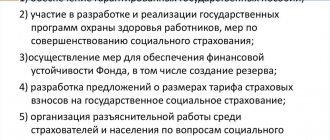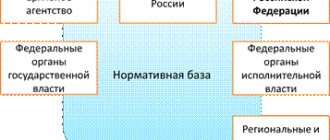What tasks are solved by the local act on the occupational safety management system in the organization?
All employers, based on GOST R 12.0.007-2009, must have a local act approved by the manager in the form of a regulation on the occupational safety management system. The absence of any relaxations regarding the use of this provision is confirmed by the content of Art. 22 Labor Code of the Russian Federation.
The described local act is an integral part of the occupational safety management system in the organization, regulated by the provisions of the GOST R 12.0.007-2009 standard. Russian legislation requires ensuring unhindered familiarization with the situation of all employees of an economic entity.
IMPORTANT! The fact of familiarization with any local act is, as a rule, confirmed by the personal signature of the employees who have become familiar with it.
Order on approval of the Regulations on OSHS at the enterprise: sample 2019
State government (budgetary, autonomous) institution (organization, enterprise) of social services “Name social service center for the population”
P R I K A Z
January 19, 2020 art. Name No. ___
On approval of the Regulations on the occupational safety and health management system in the State Public Institution SO "Name of the CSC"
Guided by the order of the Ministry of Labor and Social Protection of the Russian Federation dated August 19, 2020 No. 438n “On approval of the Model Regulations on the Labor Safety Management System”, paragraph four of clause 3.3. Charter of the Institution (the latter may not be indicated),
I order:
- Approve the Regulations on the occupational safety and health management system in the State Public Institution SO “Name of the CSC” (attached).
- Surname I.O., deputy director and Surname I.O., engineer for technical operation of the housing stock, familiarize the employees of the Institution with this provision.
- This Order comes into force on January 19, 2020.
- I reserve control over the execution of this order.
| Director | I. O. Last name |
The following have been familiarized with the order:
Download a ready-made new Order on SOUT in 2020.
https://youtu.be/KEnB6ViuaQs
What regulates the content, list and composition of sections of the regulations at the enterprise
Despite the direct legislative requirement for all employers to have this provision in place, its form, list of information, and minimum volume have not been approved anywhere at the legislative level. This circumstance causes considerable difficulties in formalizing the situation for most business entities. Moreover, each of them has to get out of the situation exclusively on their own.
Powers regarding the implementation of the standard form of the regulation in accordance with Art. 209 of the Labor Code of the Russian Federation are provided to federal government bodies. At the same time, their decision must necessarily be coordinated with institutions that supervise social policy and the state of labor relations. Despite these possibilities, there is currently no legally approved working form for this provision. However, there is a draft of this document that is available for everyone to review and is considered by government agencies as a promising option.
Thus, the result of the work of the authorized federal bodies was the emergence of a possible sample document that absorbed the content of all existing standards in the field of occupational safety management at an enterprise, formed both in the Russian Federation and abroad. What is a standard provision? More on this later.
Industrial safety and labor protection management system
When developing a policy in the field of occupational safety and health (OHS), enterprise managers must take care of creating a complete system. Today, these requirements are regulated in the Labor Code, standard standards and laws of Russia. The OSMS has key functions and tasks.
The occupational safety management system at the enterprise has the following main objectives:
- Ensure complete safety for employees in the workplace;
- Ensure the safe operation of technical equipment;
- Ensure safety at every stage of the production process;
- Normalize sanitary conditions;
- Promote safe work;
- Ensure the availability of all means that serve as personal protection for personnel;
- Ensure optimal work/rest mode.
The functions of the OSMS include assessing occupational safety indicators, organizing the necessary work in the industry in question, implementing basic safety rules and motivating workers who comply with the requirements.
What is an occupational safety management system?
An OSMS is a set of interrelated rules, regulations, procedures and processes that ultimately should create safe working conditions in the field. An approximate diagram and content of all components of the occupational safety management system should be described, starting from the top - the management body. He is the manager or chief engineer, who has at his disposal tools such as legislation and management decisions. With their help, occupational safety activities are ensured in all structural divisions.
The second level in the structure is the organizational and methodological body. He assists senior management in developing rules and requirements, and also monitors their implementation in the field. Most often we are talking about the OT department. Representatives of the trade union committee, as well as employees of the medical unit of the enterprise, help him in carrying out his functions. Next comes the information body, which must process, summarize and present information on a specific industry. With various changes in the regulatory framework, it is this body that reports which new rules have come into force and which have ceased to apply.
The last component level in the structure is the control object. This concept implies the activities of various organizational services to ensure safety in the workplace.
Contents of the standard provision
The draft model provision sets out the following points:
- a list of sections that must necessarily be included in the provision and the sequence of their presentation;
- an indication of the objectives pursued in the field of labor protection;
- reflection of the mechanisms, methods and algorithms through which the labor protection process will be implemented;
- the procedure for organizing personnel training in the field of ensuring safe work, the frequency of its implementation;
- procedures for organizing document flow on labor protection.
As a result of an analysis of the resulting draft, at a meeting of the tripartite commission, which took place in early 2020, it was decided to rework the document due to the flaws it contained. Since the final version was never adopted, business entities will have to develop samples and instructions for them on their own. In order to solve this problem, a more detailed consideration of the instructions in this regard available in the legislative framework is required.
List of applications
In addition to the regulation itself, depending on the type of activity of the company, there may be annexes that specify some issues about labor protection. Such applications may include:
- provision on the availability of special log books, which are under the jurisdiction of the labor protection officer;
- a list of special events and a schedule for their implementation, which are carried out in order to increase the level of personnel knowledge about work safety;
- a list of persons responsible for activities in this area;
- a list of regulations in accordance with which this act can be drawn up.
Difficult issues when developing internal labor protection documentation
Responsible for the creation of the described local act are assigned to employees whose responsibilities are assigned to this by internal orders and job descriptions. Based on the contents of paragraphs. 4.5.1 and 4.5.2 GOST 12.0.230-2007, we can conclude that the most significant points from the point of view of drafting the regulations will be:
- scale of activity;
- technology and production volume;
- business areas covered by the interests of the economic entity;
- clarity and accessibility of the situation for the perception of an ordinary employee;
- the need for regular evaluation and improvement of the document.
That is, the document being created should not be static, unchanging in nature and regularly subject to changes due to the emergence of new requirements, expansion of the interests of the business entity and the publication of additional government acts.
Nuances of developing regulations on the occupational safety management system at the enterprise
The regulations are prepared by responsible specialists of the employing company. In accordance with paragraphs. 4.5.1 and 4.5.2 GOST 12.0.230-2007 when developing documentation within the framework of the labor protection system, it is necessary to pay attention to the following nuances:
- one should take into account the size of the organization, the types of activities it carries out, the specifics of the technological processes that characterize its production;
- the content must be presented in a form that will be understandable to employees;
- documentation must be analyzed and corrected in a timely manner.
Thus, when developing a regulation, it should be taken into account that it is not adopted once and for all, but may require periodic changes.
Typical list of sections of the regulation
The position being formed for an economic entity may consist of the following parts:
- title part;
- general provisions;
- labor protection functions performed by all employees;
- the structure of business units related to ensuring labor safety;
- procedure for completing occupational safety training;
- procedure for assessing and improving existing processes in the field of occupational safety;
- algorithm of actions of employees in the event of emergency situations;
- employee liability for non-compliance with labor safety regulations;
- additional documents serving as an appendix to the position.
And in the following sections we will consider each part of the provision in more detail.
SUOT - what is it?
The concept of a labor protection management system is given in Article 209 of the Labor Code of the Russian Federation and is defined as a single mechanism of interacting and interconnected elements that establish the employer’s policy in the field of labor protection. At the same time, procedures are determined to achieve the set goals.
To help the organization develop an OSMS, the order of the Ministry of Labor approved regulation No. 438n dated August 19, 2016.
The system is part of the management (control) of the organization. It is precisely this that allows not only to reduce the risks of dangerous and harmful production factors, to create a favorable, safe environment in the field, but also to increase labor productivity.
The OSMS represents a unity:
- local regulatory framework of the employer and maintaining the necessary documentation with recording of actions in acts, journals and other accounting registers;
- organizational management measures with the assignment of labor protection responsibilities to officials;
- procedures and operating procedures of the system, including planning, ways of implementing activities that are important for improving organizational occupational safety methods and working conditions.
The provisions and requirements of the OSMS are mandatory for all employees of the organization. For normal operation of the system, the employer must:
- create its structure,
- clarify the connections between the structural units of the organization;
- distribute responsibilities in the field of labor protection for each of the divisions (departments, workshops, etc.),
- assign a measure of responsibility to officials in the field of occupational safety.
All these functions must be secured by regulatory documents.
Description of general provisions
A sample list of issues covered in this section might look like this:
- what problems are supposed to be solved using the document;
- what areas of work are regulated by the regulations;
- what standards specified in the document must be observed by all employees without exception;
- why the document was declared as fundamental in terms of regulating procedures for assessment, training and development of personnel in the field of labor protection;
- on the basis of instructions, information on which legislative provisions the document is constructed and its application is ensured;
- What are the document review periods in the organization?
Structure and content of the Standard Regulations on OSMS
OSHMS: occupational safety and health management system
The TP, approved by Order of the Ministry of Labor 438, contains 10 main sections.
TP structure, which must be approved by the manager
More details about the contents of the sections:
- The established regulatory body must function in compliance with a number of requirements: compatibility with all control elements; unity with the structure of the company. It is not necessary to adapt the situation yourself; you can involve third-party contractors to help.
- Directions in the field of occupational safety policy should be formulated taking into account the need for safe working conditions for all company employees.
- The target policy is formed based on the possibilities of achieving a specific result.
- The distribution of job and functional responsibilities in the occupational safety system is regulated.
- Determines a set of measures in the field of labor protection necessary to achieve the intended goals.
- Taking into account the current state of the occupational safety and health system, the results of complex measures, and possible implementation deadlines, an occupational safety plan is drawn up. Project implementers and acceptable sources of funding are also indicated here.
- The functioning of the OT system must be monitored. Monitoring is developed on the basis of internal activities and taking into account the work of supervisory authorities.
- Planning for improving the occupational safety and health system is carried out taking into account the assessment of: control of work and implementation of activities; third party OT system organizations; the results of identifying the causes of non-standard situations.
- This part of the document establishes the potential manifestation of emergencies and emergencies, the procedure for action if they occur. A plan for investigating such incidents is also being developed here.
- The conclusion must include a list of all documentation for this line and the circle of persons responsible for the development and implementation of SOUT projects.
Actions in case of an accident
Functions of an employee for the purpose of implementing labor protection regulations
The title of this section fully corresponds to its content, since it includes the names of the positions of employees who are obliged to:
- monitor and evaluate the existing occupational safety and health management system;
- determine the level of compliance of current local acts with the requirements of laws, regulations and government regulations;
- examine the degree of compliance with adopted internal documents in the field of labor protection by employees;
- formulate proposals for optimizing existing procedures in the field of labor protection, participate in their implementation in the company’s practice;
- implement training for employees in order to acquire new knowledge in the field of occupational safety;
- ensure the implementation of the necessary procedures in terms of supplying workers with protective equipment, regulations, safety equipment, and infrastructure facilities in the field of labor protection;
- resolve the consequences of emergency incidents and conduct an appropriate investigation, document its results;
- ensure the receipt of social benefits and rehabilitation procedures for persons affected by accidents and occupational diseases at work;
- conduct a special assessment of workplaces based on working conditions;
- ensure the involvement of third-party specialists to train employees in labor safety rules;
- assess the correctness of document flow in the field of labor protection and make the necessary adjustments to existing procedures.
What is an OSMS?
The new Occupational Safety and Health Management System (hereinafter referred to as OSH) is part of the overall management system that ensures risk management in the field of health and safety associated with the activities of an enterprise or organization.
At any enterprise, the Regulations on OHSMS determine the procedure and structure of occupational safety management and serve as the legal, organizational and methodological basis for the formation of management structures and regulatory documents. The object of management is labor protection, as a system for preserving the life and health of workers in the process of work, which includes legal, socio-economic, organizational and technical, sanitary and hygienic, treatment and preventive, rehabilitation and other measures.
This Regulation applies throughout the entire territory of the organization, in all its buildings and structures. The requirements of the OSMS Regulations are mandatory for all employees of the organization.
Here you can find a free example of the new OSH Regulations and an order for its approval and adapt it to the needs of your enterprise.
Description of the organizational structure of labor protection management bodies
The most significant unit carrying out work on labor protection is the labor protection service, which, in accordance with Art. 217 of the Labor Code of the Russian Federation, is formed in all companies with more than 50 employees. In organizations with a more modest staffing, it is enough to have one specialist who will be responsible for labor protection. This person can be the head of the organization or the private entrepreneur himself. It is possible to engage an external specialist under a GPC agreement, who will ensure the implementation of all necessary procedures in the field of labor protection.
The provisions of the described section may indicate that:
- in what form will labor protection be regulated in the company: by creating a service, appointing one person in charge, or attracting an external expert.
- How are the powers and responsibilities of a service or specialist linked to the provisions of Art. 217 Labor Code of the Russian Federation.
- which person has the right to sign an order to create the appropriate unit or appoint a specialist.
- what problems the service or specialist should solve on a regular basis.
OSMS at the enterprise
When developing an OSMS, you must be guided by the Standard Regulations on the Occupational Safety and Health Management System, approved. by order of the Ministry of Labor of Russia No. 438n dated August 19, 2020, and do the following:
1. To organize and operate an OSMS, adopt a special local act - Regulations on the labor safety management system in the organization, which the employer develops independently. Also, to develop this document, the employer has the right to involve third-party organizations and individual specialists. The regulation must be approved by order of the employer, taking into account the opinion of the employees of the enterprise or their authorized representative bodies (if they exist at the enterprise).
2. To organize an OSMS in 2020, it is necessary to develop another regulatory document - the Labor Safety Policy, which will be part of and included in the Regulations on the OSHS. The policy reflects:
- provisions that the conditions provided for the performance of labor duties in the workplace comply with all labor protection requirements and conditions;
- the employer's obligations to ensure the safety and health of workers and prevent injuries;
- provisions on taking into account the characteristics of the company’s activities and the types of economic activities carried out by it, which determine the level of professional risks of the company’s employees;
- procedure for working and improving the functioning of the OSMS.
The occupational safety policy must be available to all employees and other persons located in office buildings, on the territory and other structures of the employer. For example, it could be posted on a public notice board for everyone to see.
3. Create an OSMS structure and ensure the distribution of responsibilities in the occupational safety management system at the enterprise between responsible (officials) persons. To do this, you need to set the system control levels, which can be as follows:
- level of an individual production team;
- production site level;
- the level of the employer as a whole, and so on.
Based on the characteristics and specifics of the employer’s activities, the management structure and the number of employees, other levels of management can be established for the purposes of the occupational safety and health management system.
The following may be responsible for organizing labor protection:
- directly the employer himself (for example, if he is an individual entrepreneur);
- individual heads of structural divisions;
- a specially created labor protection service;
- occupational safety specialists;
- an organization or individual specialist who provides services in the field of labor protection, specifically engaged by the employer.
If the employer’s company employs less than 15 people, then the structure of the occupational safety and health system can be simplified, provided that all state labor protection requirements are taken into account and observed. When simplifying the structure, the specifics of the organization's activities are taken into account and the levels of management between the employer and employees are reduced.
In addition, within the framework of the occupational safety and health management system and in accordance with the Regulations on the occupational safety management system, the employer must carry out:
- development and planning of actions and measures for the implementation of labor protection procedures;
- monitoring the operation of the OSMS and monitoring the implementation of procedures;
- operating procedure and improvement of the functioning of the OSMS;
- response to accidents, incidents and occupational diseases;
- work and management with OSMS documents.
Consolidating the frequency and methodology of employee training
In this part of the provision you need:
- approve the obligation of all newly hired persons to undergo preliminary safety training in the workplace;
- reflect the content of the briefings that employees undergo;
- determine the methodology of training events and the procedure for familiarizing new employees with instructions;
- provide regulations that affect the procedure for conducting briefings and training of employees;
- indicate the persons who have the right to approve training programs, the content of instructions and methods of familiarization with them;
- prescribe how to evaluate the acquired knowledge after the completion of the briefing procedure;
- indicate the need to carry out introductory procedures in strict accordance with local regulations adopted by the company;
- determine the validity period of the company’s applicable familiarization procedures, briefings and training plans.
Assessment of employee training in the field of labor protection
This part may be limited by the following provisions:
- periods and deadlines at the end of which the employee must undergo a safety knowledge assessment;
- conditions for carrying out surprise inspections of employees' compliance with labor safety rules;
- a list of legislative documents on the basis of which unannounced inspections of employees in the field of occupational safety are carried out;
- list of persons who are responsible for testing knowledge.
Analysis and improvement of labor protection mechanisms in the company
To describe optimization procedures in the field of labor protection, the document may include the following points:
- a list of persons who regularly check the existing system and develop proposals for its improvement;
- parameters that are analyzed in the process of assessing existing mechanisms;
- a list of tools used to assess the current state of the labor protection system;
- procedure for administering the work of employees analyzing and optimizing the labor protection system in the organization.
Approval of rules of conduct and sequence of actions in case of accidents
A rather important part of the provision, which states:
- the procedure for investigating accidents, the techniques used;
- a list of priority measures that employees and managers should take in the event of an accident;
- regulations for the approval of local documentation defining the methods and procedure for conducting the investigation;
- information about persons who are obliged to take the necessary measures in the event of an accident;
- procedures for interaction between the company, external services and government agencies in the event of an accident;
- a list of documents drawn up upon the occurrence of facts leading to adverse consequences for employees, and the procedure for entering relevant information into them;
- a list of persons responsible for documenting the facts of incidents that occurred.
Responsibility for non-compliance with labor protection rules
The part devoted to the consequences of non-compliance with the provisions prescribed in the local act is standard. Regarding labor safety rules, the document may include the following items:
- Links to the legislative framework that allows employees to be held accountable for non-compliance with the rules;
- Introducing the possibility of applying punishment to all employees of an economic entity, listing all possible methods of influence.
The provision may also include numerous annexes. More on this in the next section.
Additional materials attached to the regulation
The described document may have as attachments copies of the regulations on which it is based and which give it legitimacy, internal local acts of the company necessary in the process of labor protection. Copies are attached for the information of all interested parties.
In addition, the application can be a log of employees’ familiarization with the specified provision, where they certify the fact of reading (receiving in hand) one copy. It would be useful to add a log that records the fact that the employee has undergone safety training. It may also record the employee's access to equipment and premises. All listed journals that act as appendices must be numbered, and it is advisable to enshrine their forms in the text of the regulation.
All applications must be approved by order of the manager. In addition, they must contain a note indicating that they are specially formed as appendices to the regulations on the labor protection system. As a rule, this is done in the same administrative document that introduced the provision and which is indicated in its title part. Thus, it will be possible to use the applications separately and transfer them to company employees.
If an accident occurs in the organization, will the labor inspector request the OSH regulations?
In the event that an industrial incident occurs in an organization with a group of people, which has serious consequences or death, an unscheduled inspection will be carried out by an employee of the State Labor Inspectorate. It is carried out twice: during the investigation of the accident and after its completion.
The GIT inspector may appear for an inspection without prior notice within 20 working days. He must request all documents regarding compliance with labor protection requirements, both in relation to the victim and in the organization as a whole. This applies to the provisions on special labor conditions and personnel documents to establish the legality of labor relations with the victim:
- employment contract;
- T2 cards;
- time sheets.
All identified violations will be reflected in a report with an order and deadline for their elimination. After the expiration of the period specified in the act, the GIT inspector will again come to the organization for inspection and check whether the requirements of the act have been fulfilled.
An employer who fails to eliminate identified violations will be fined on the basis of a protocol on an administrative offense drawn up by a GIT inspector. The protocol is then submitted along with other investigation materials to the court.
The fine ranges from 100 to 200 thousand rubles.
***
Existing standards oblige all employers to have specialized provisions regulating the occupational safety and health management system. However, at present there is no clear form of such a local act; none of the existing legislative acts has introduced it. In this regard, business entities need to independently develop its form, a list of sections and determine their content. The option we have presented takes into account the latest trends, as well as existing standards and provisions of regulations, and therefore can be successfully used by most employers for the purpose of practical development of the specified internal document.
Similar articles
- Model training program on labor protection
- Sample order for the creation of a labor safety commission
- Model training program on labor protection
- Standards for the number of workers, managers, specialists and employees
- Sample regulations on the occupational safety management system
Required for approval
In mid-October 2020, the Russian Ministry of Justice registered Order No. 438n of the Ministry of Labor dated August 19, 2020, which approved the approximate regulations on the labor safety management system. This should be the case in every enterprise. This means that you need to understand how to draw up an order on OSH (a sample will be provided below in the article).
In general, an organization can develop a basic document on OHSMS either independently or with the help of third parties - private specialists and labor protection firms in the given area in which the organization operates.
Also see “What should be the occupational safety management system at the enterprise since 2016.”
The seventh paragraph of the order of the Ministry of Labor obliges the employer to issue an order approving the OSMS (developed regulations on it). Moreover, this must be done taking into account the opinions of employees and/or their authorized representative body (if there is one).
The legislation currently does not impose any further requirements for the order to implement an OSMS. Therefore, in our opinion, an order on the enterprise’s occupational safety and health system can be issued:
- as a separate order;
- implement an OSMS developed for the organization, taking into account its specifics.
Of course, this document is signed by the head of the enterprise, since it is he who bears the responsibility to create and put into circulation an adequate occupational safety management system.
Fresh materials
- Certificate of non-admission to the apartment, sample EVERYTHING THAT CONCERNES THE COMPANY BURMISTR.RU CRM system APARTMENT.BURMISTR.RU SERVICE FOR REQUESTING EXTRACTS FROM ROSSREESTR AND CONDUCTING…
- Balance sheet of JSC Accounting (financial) statements of enterprises 39,149.84 billion rubles — JSC VTB CAPITAL 4,892.93 billion…
- Tax planning Tax planning in an organization Tax planning can significantly affect the formation of the financial results of an organization,…
- Exemption from VAT Notification of the use of the right to exemption from VAT Notification of the use of the right to exemption from VAT...








